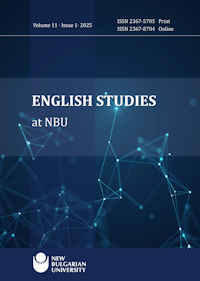Metafiction and representation of gendered identity in Gillian Flynn’s ‘Gone Girl’
DOI:
https://doi.org/10.33919/esnbu.25.1.4Keywords:
metafiction, identity, empowerment, victimization, Gillian Flynn, Gone GirlAbstract
This study examines the interplay of gender stereotypes in crime narratives through the lens of Gillian Flynn's Gone Girl. Flynn's novel challenges traditional portrayals of women in crime fiction, positioning them not merely as victims but as complex anti-heroines capable of orchestrating elaborate criminal plots fueled by vengeance and psychological manipulation. The paper highlights the metafictional elements in Gone Girl, where the author employs self-conscious storytelling to critique societal expectations surrounding gender roles. By intertwining themes of media representation, domesticity, and the neoliberal notion of choice, the paper underscores how Flynn's narrative structure critiques the commodification of female identity and the performative aspects of gender roles and identity. Ultimately, the study posits that Flynn's work serves as a thought-provoking commentary on the power dynamics inherent in the representation of gender in contemporary media culture, revealing the complexities of identity as shaped by societal constructs.
References
Banet-Weiser, S. (2018). Postfeminism and popular feminism. Feminist Media Histories, 4(2), 152-156. https://doi.org/10.1525/fmh.2018.4.2.152
Christensen, A. E. (2020). “Catastrophically Romantic”: Radical Inversions of Gilbert and Gubar’s Monstrous Angel in Gillian Flynn’s Gone Girl. American, British and Canadian Studies, 35, 86-110. https://doi.org/10.2478/abcsj-2020-0018
Flynn, G. (2012). Gone girl. Hachette.
Gill, R. (2007) Postfeminist media culture: Elements of a sensibility. European Journal of Cultural Studies, 10(2), 147-166. https://doi.org/10.1177/1367549407075898
Hoeveler, D. L. (1995). Gothic Feminism: The Professionalization of Gender from Charlotte Smith to the Brontës. Pennsylvania State University Press. https://doi.org/10.1515/9780271072449-003
Irigaray, L. (1985). This Sex which is not One. Cornell University Press. https://doi.org/10.36019/9780813568409-028
Johansen, E. (2016). The neoliberal gothic: Gone Girl, Broken Harbor, and the terror of everyday life. Contemporary Literature, 57(1). 30-55. https://doi.org/10.3368/cl.57.1.30
Kennedy, V. (2017). “Chick Noir”: Shopaholic Meets Double Indemnity. American, British and Canadian Studies, 28, 19-38. https://doi.org/10.1515/abcsj-2017-0002
Madhok, S, Phillips. A & Hemmings. (2013). Gender, Agency, and Coercion. Springer. https://doi.org/10.1057/9781137295613_7
Miller, E. (2018). Domestic Noir and the Active Turn in Feminist Crime Fiction. In L. Joyce & H. Sutton (Eds.), Domestic Noir: The New Face of 21st Century Crime Fiction, (pp. 89-113), Palgrave. https://doi.org/10.1007/978-3-319-69338-5_6
Schneider, E. M. (1993). Feminism and the false dichotomy of victimization and agency. NYL Sch. L. Rev. 38. 387-399.
Edwards, Sh. (2023). 8 Takeaways from our Interview with Gone Girl Writer Gillian Flynn. Screen Craft. screencraft.org/blog/8-takeaways-from-our-interview-with-gone-girl-writer-gillian-flynn/
Sutton, H. (2018). Gone Genre: How the Academy Came Running and Discovered Nothing Was As It Seemed. In L. Joyce & H. Sutton (Eds.), Domestic Noir: The New Face of 21st Century Crime Fiction, (pp. 53-69) Palgrave. https://doi.org/10.1007/978-3-319-69338-5_4
Philips, D. (2021). Gaslighting: Domestic Noir, the Narratives of Coercive Control. Women: a Cultural Review, 32(2), 140-160. https://doi.org/10.1080/09574042.2021.1932258
Waugh, P. (2002). Metafiction: The Theory and Practice of Self-conscious Fiction. Routledge. https://doi.org/10.4324/9780203131404-18
Wolf, N. (2013). Fire with Fire: New Female Power and how it will Change the Twenty-first Century. Random House. https://doi.org/10.5860/choice.31-5175
Downloads
Published
How to Cite
Issue
Section
License
Copyright (c) 2025 Soheila Farhani Nejad

This work is licensed under a Creative Commons Attribution-NonCommercial 4.0 International License.
Access Policy and Content Licensing
All published articles on the ESNBU site are licensed under the Creative Commons Attribution 4.0 International License (CC BY 4.0). This license permits unrestricted use, distribution, and reproduction in any medium, provided the original work is properly cited. It allows reusers to distribute, remix, adapt, and build upon the material in any medium or format, even for commercial purposes. The terms on which the article is published allow the posting of the published article (Version of Record) in any repository by the author(s) or with their consent.
Note that prior to, and including, Volume 10, Issue 2, 2024, articles were licensed under the Non-commercial (CC BY-NC 4.0) license. The transition to CC BY 4.0 is effective as of Volume 11, Issue 1, 2025.
In other words, under the CC BY 4.0 license users are free to
Share — copy and redistribute the material in any medium or format for any purpose, even commercially.
Adapt — remix, transform, and build upon the material for any purpose, even commercially.
Under the following terms:
Attribution (by) - You must give appropriate credit (Title, Author, Source, License), provide a link to the license, and indicate if changes were made. You may do so in any reasonable manner, but not in any way that suggests the licensor endorses you or your use.
No additional restrictions — You may not apply legal terms or technological measures that legally restrict others from doing anything the license permits.
Notice: No warranties are given. The license may not give you all of the permissions necessary for your intended use. For example, other rights such as publicity, privacy, or moral rights may limit how you use the material.
If the law requires that the article be published in the public domain, authors will notify ESNBU at the time of submission, and in such cases the article shall be released under the Creative Commons Public Domain Dedication waiver CC0 1.0 Universal.
Copyright
Copyright for articles published in ESNBU are retained by the authors, with first publication rights granted to the journal. Authors retain full publishing rights and are encouraged to upload their work to institutional repositories, social academic networking sites, etc. ESNBU is not responsible for subsequent uses of the work. It is the author's responsibility to bring an infringement action if so desired by the author.
Exceptions to copyright policy
Occasionally ESNBU may co-publish articles jointly with other publishers, and different licensing conditions may then apply.






